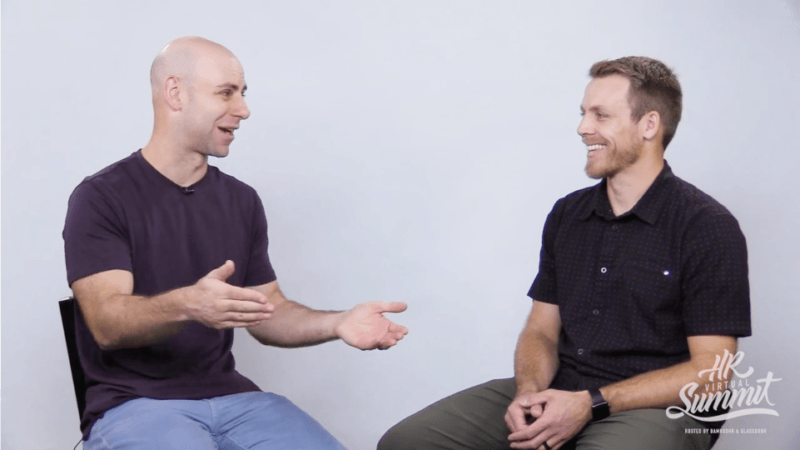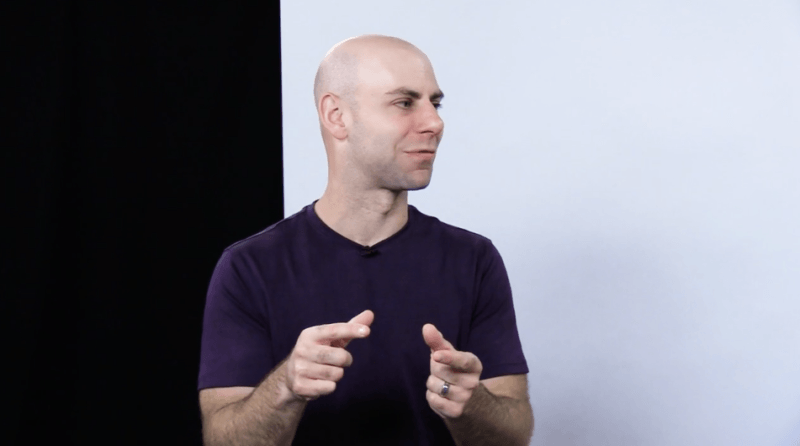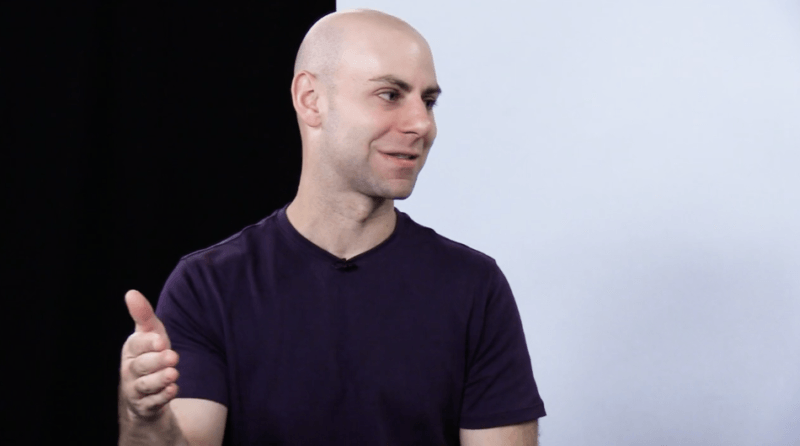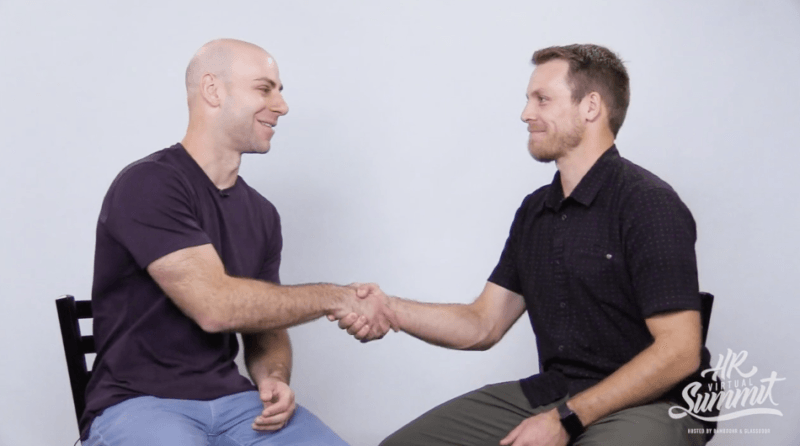Adam Grant on Creativity, Culture, and Open Feedback: HR Virtual Summit Recap
HR Virtual Summit 2018 was a resounding success, with more than 30,000 attendees participating in hours of training and thought leadership. As one of the keynotes for this record-breaking conference, BambooHR’s own Brenton Williamson got to sit down with Adam Grant, a professor at the Wharton School of the University of Pennsylvania specializing in organizational psychology and the author of Give and Take: A Revolutionary Approach to Success and Originals: How Non-Conformists Move the World. They discussed several ways that HR can encourage original thinking in their organizations and reap the benefits. Here are some excerpts from this session, condensed and edited for clarity.

Brenton Williamson: What is an original? What’s the concept behind that?
Adam Grant: I’ve always seen myself as not creative. I feel like my thinking is very linear. I like to get things done according to a plan, and I usually like to know what the evidence says has worked in the past before I act on something in the present. I feel like that has really constrained my ability to come up with novel solutions to problems and fresh ideas.
I think in some ways, Originals was my attempt to make up for that, and say, “look, you don’t have to be somebody who has a Eureka! moment every day in order to be an original. I think we all know creativity is generating ideas that are novel and useful. I think of being an original as being somebody who takes the initiative to make those ideas a reality. And so you don’t always have to be the source of those ideas. It could mean that you collaborate with somebody who is really creative, and you’re brilliant at execution, or at selection in figuring out which ideas are worth implementing in the first place. In some ways, I would say if you’re not creative, it’s not too late.
The Difference Between Originality and Creativity
Williamson: What is the difference between originality and creativity? You touched on it, but would you mind diving deeper into the difference?
Grant: Creativity is all about idea generation, it’s about coming up with alternatives that advance whatever goal you’re trying to achieve in a way that is different than what has been done before. Originality picks up where creativity leaves off. Let’s say you have an idea, or somebody else has an idea. How do you know if it’s any good? Because we constantly see people bet on bad ideas. I think there’s a long list of those that have become failures, especially in the entertainment industry. Think of any bad movie that you’ve ever seen.
We also see good ideas rejected all the time. Star Wars and E.T. were both shot down originally, the studios that had a chance at them didn’t go for them. Larry and Sergei tried to sell Google for about a million dollars in the early stages, and their potential purchaser decided they didn’t want it. We look at Blockbuster, hey, had a chance to buy Netflix. Whoops.
Idea selection is the first stage in being original; knowing which of your ideas have potential, and also which ideas other people are bringing that are worth pursuing. And from there, it’s about championing those ideas effectively; speaking up in ways that get heard, building coalitions, being able to implement them. To me, that’s where originality really thrives.
Williamson: It’s taking the next step after creativity, making it happen.
Grant: That’s what I should have said. (laughs)
The Value of Original Thinkers
Williamson: Most everyone here is here in some capacity to figure out “What can I do to help my organization be better, take it to the next level. So my question is: what value do original thinkers bring to an organization?
Grant: The value of original thinkers is about driving innovation and change. Too often, organizations get stuck in the status quo. Most of the organizations I work with across industries are really into conformity. They have a set of practices and principles and the way you get evaluated and promoted and rewarded is by essentially conforming. I think that’s dangerous.
I think that’s a great way to fall into patterns of groupthink, where people are all marching in the same direction and are really excited about their alignment, but no one questions whether that’s the right direction to be marching in the first place.
What original thinkers do is shake up the status quo. They challenge you to think differently. They force you to question assumptions that you’ve been taking for granted but need to be re-thought. And they create cultures where people are never satisfied with the way things have always been done.
That’s my least favorite phrase to hear in an organization: “well, this is the way we’ve always done it!” Well, first of all, who told you that was a good way? Second of all, who told you that it would be a good way today? And third, why would you just want to repeat the successes of the past, opposed to trying to build on those and improve on them?
Williamson: You lose iteration, and the opportunity to rise and progress.

Culture Fit vs. Culture Contribution
I’d love to hear some specific examples of an original thinker or an organization that’s promoting original thinking, and how that has helped their organization grow or progress.
Grant: One of my favorite examples is IDEO, one of the world’s most innovative design firms. One of the things they started doing early on, like saying that we want people with great skills, and we want a lot of people who will be stars in the future, who have a very high ceiling on their potential. But most of all, we want culture fit. Because of course, if people don’t fit your culture, it’s going to be hard for them to contribute. If you’re clear about culture fit, you can attract people who are uniquely talented, you can retain them, because, where else would would I want to work? This is the one place where I get to live my values. And then they feel really motivated, because they feel like they found their home.
If you look at the data, there’s a study that I love of over 200 startups in Silicon Valley over a decade and a half. The ones that put a premium on culture fit do better. They end up being less likely to fail, and they’re also significantly more likely to IPO.
And you say, OK, great, culture fit is the way to go. Except then if you track them after they go public, the companies that are really into culture fit grow at slower rates when you track metrics like annual market capitalization. As they look for people who fit the culture, they start to weed out of diversity of culture.
There’s a great study by Lauren Rivera at Northwestern who went into consulting firms, investment banks, law firms, a whole bunch of professional service worlds, and tracked what people were paying attention to when they gauged culture fit. So if we were sitting down in an interview, how would I figure out if you fit the culture? And the way that I answer that question is by saying, “how are you similar to me?”
People emphasize similarity; you fit the culture by being just like me, and you don’t fit the culture if you’re different from me. That destroys diversity of thought.
So what IDEO said was “what if we abandon culture fit, and instead we shift to culture contribution?” Instead of asking, when I bring in a new person or when I think about who to promote into leadership, “does this person fit the culture?”, instead, we’re going to ask, “can this person enrich the culture by bringing something that’s absent?” Then you’re much more likely to value diversity as opposed to shooting it down.
One way (IDEO) did this was by saying “we need more background diversity. We’re great at design thinking, we’ve put that on the map. But we’re getting called to do these increasingly odd projects.” They were called into a grocery store and they had to reimagine a shopping cart. Their designers are good at that, but they don’t know anything about grocery stores or shopping carts, other than what a consumer would know.
So they said, “who is good at understanding a foreign world and making sense of that?” That’s what anthropologists to for a living. So they created a new job description called an Anthropologist and hired people with that background, and they brought in three or four. Pretty soon, they said, “Wow, this is amazing! We should only hire anthropologists!” And then they realized that they were falling into the same trap that they did before.
So every time that they have that feeling, that somebody is adding something new to the culture, they know it’s time again to ask, “what else is missing from the culture? How do we enrich it?”
When I was working on a project at Google a few years ago, one of the things Larry Page said that stuck with me was “We do not want to become a cultural museum. We don’t want to figure out what worked in the culture in the past, freeze it, and treat it as some relic to try to maintain. We want to continue changing and evolving our culture.”
Hiring and Onboarding for Diversity
Williamson: That seems like an easy trap to fall into, because it’s working. You’re bringing on people who are like you, it feels great, and there’s great collaboration, and you’re having so much fun. What can a person in HR do to help managers and executives understand, “Hey, we need to pause for a second and figure out who else can contribute, not just our buddies?”
Grant: I can think of three answers to this question. First, you can get at this in the interview process. One of my favorite questions to ask at the end of a job interview is “you’ve just been through our interview process. How would you change it? What would you fix that is broken?” You get an immediate window into whether that person is willing to challenge the status quo. You also get to see how they present that. You’ve started the relationship off on a different foot, where they feel that this is somewhere they can go with their ideas, and they really have a voice around here.
The second thing is when you’re onboarding people, there’s some really cool research that Brandon Stotts did a couple of years ago (a tech company) onboarded people and randomly assigned them into three different groups.
One group was the control group, they went through standard socialization. The second group was brought in to feel pride in the company. I see a lot of companies do this, to say, “let’s talk about our values, our practices, we want to help you understand how we work so you can become one of us.”
And then there was a third group where they asked, what if we did the reverse? What if we help you think about what you have to contribute here? And we ask you what your strengths are, and we encourage you to bring them to the table?
That third group was significantly less likely to quit. They also had significantly higher customer satisfaction scores over the next six months. When you onboard people and say, “look, we want your unique contribution,” you signal that their ideas are valued from day one.
I’ve worked with a couple of organizations that have said, let’s formalize that—we all run exit interviews in HR. What if we flipped that on its head and run entry interviews, where, in the first week we ask the questions that we would normally ask on your way out the door?
- Why did you come?
- What are your goals over the next five years?
- What do you see that’s working in the culture?
- What would you improve?
The great thing about having this conversation during onboarding is that it’s way less awkward than if you have it after the employee has been here for three years: “By the way, I know I’ve never asked you this before, but what would you have liked to change over the last three years?”
It’s more beneficial to do it up front, because when people first join, they’re in this great insider/outsider position: they’re observing the culture and they have access to it up close, but they haven’t yet drunk the Kool-Aid, so they can see it more clearly, with more objectivity or distance. I love to see these entry interviews implemented wherever possible.
Williamson: What do you feel the organization’s responsibility is to learn from or adopt or pull from those new hires at that point? Eventually, those new hires may well conform to the status quo. So how do you capitalize on those first few weeks or months?
Grant: It’s useful to recognize that when people first join, they don’t know how to do their jobs yet. They’re scrambling to try to figure out how to get up to speed, how to accumulate all the knowledge and skills and connections they need to be effective.
As they move up the learning curve, they still feel like they’ve kinda figured out what they’re doing, but they’re not good yet, and it’s going to take them a while to get there. One thing that every organization has a responsibility to do is to make sure that people feel that they can contribute in the meantime.
One of the easiest ways is to have that conversation is, as one organization said, we’re going to treat this as culture detectives. Your job in your first month is, in addition to learning your job, as you meet people, ask them what they think is working in the culture and what needs to be improved. If they were in charge, what is the one biggest change they would make to the culture? As you gather that, you can become our eyes and ears and you can report back at the end of the first month:
- What did you learn about the culture?
- What surprised you?
- What changes did you hear about over and over again?
If you give people the opportunity to speak up in that way, it gives them the chance to take ownership of the culture.

What HR Can Do to Change Culture
Grant: One of my biggest frustrations when I work with organization is people who say “I’m at the bottom of an organization with lots of people. There’s nothing I can do about the culture. That’s for leaders.” And yes, it’s true that leaders have a disproportionate impact on culture.
But what is culture? Culture is the set of values that you espouse and enact. It’s about the principles you think are important and that you show are important through what you prioritize and what you pay attention to. Ultimately, culture is what we do every day when no one is looking. If you believe in that and you want to change the culture, all you need to do is start changing your own actions and start getting other people to come on board with the change that you want to see happen.
It’s a little bit Gandhi to say “Be the change that you want to see in the world”, but I think that’s one way that you start to catalyze conversations about shifting a culture.
Williamson: One of the most frequent questions we get from HR folks: what if something like culture and values is not a priority for the executive team or upper management?
Grant: Leaders may get the importance of culture but not the change you’re trying to advocate for.
Find the bright spots. Even if you think your leaders don’t get it, there are probably some leaders who get it a little bit more than most of their peers. Your opportunity is to go to those people and say, “I see that you’ve made some culture change. I’d love to learn how you did it.” Or better yet, you find a pocket of the organization where people are already enacting the change you hope to see happen. Your job is to go to these people and ask them for advice. “I’d love to replicate or expand some of the adjustments that you’ve made. I know that you’ve had a lot of success. How have you done it, and what guidance can you offer me?”
There’s a bunch of research by Katie Liljenquist and her colleagues that says we love to be asked for advice. It’s one of the most neglected ways to influence other people. There’s an old saying that we all admire the wisdom of people who come to us for advice. The advisor ends up feeling that it’s nice that their opinion was respected, and they also have to take your perspective and think, ”What would I do if I were in your shoes?” They are then much more likely to give you good suggestions or to become your advocate and try to help you make it happen.
The first thing I often recommend to people who are trying to exercise change from the bottom or the middle is this:
Look around your organization. Find the people who have a track record of challenging the status quo who have driven change. Seek their advice. If you have four or five of these conversations, you now may have a team of advocates to work with you.
Williamson: You’re feeding the good, instead of focusing on the negative of the people who aren’t bought in.
Grant: Very often there are people who are building on those successes already and increasing the value they they’re creating for the organization.
The Importance of Open Feedback
Grant: It’s frustrating how often I go into organizations and this gets is taken to far. The thinking by some leaders is that “we want people to only be positive”. And of course when you’re trying to drive change, especially in culture, you want people to be enthusiastic and optimistic and inspired and hopeful. But often times, the best motivator for change is a problem that needs to be solved, and I think that too many leaders make it too hard to voice problems.
The audience can fill in the blanks: don’t bring me ______, bring me ______. Usually, what people say is “don’t bring me problems, bring me solutions.” Did all these people work for the same boss?
I get why leaders say this. I think they’re trying to encourage people to be constructive, not complaining. But I think this is a dangerous philosophy. If people can only speak up if they have a solution, you might never hear about your biggest problems that are too complex for any one person to solve alone. I love to see organizations make it possible to bring their problems to the table. What if you converted your suggestion box into a problem box? If you see anything that is broken, you can say, “I think this is an issue.”
I was thinking about the difference between complaining and bringing up problems. The key is to provide a channel where people can communicate the problems that they’re seeing. It’s not a venting channel to go vent about the things you hate. It’s enabling individuals to come, be open, and say, “I see a problem here.”
It’s creating psychological safety, so people can say, “If I think the emperor has no clothes, I can say that without first becoming a professional tailor. I care about this problem, I’m willing to think about it. I don’t know if I can solve it, but I want to make sure I do something to get it addressed.”
How to Avoid Cognitive Entrenchment
Williamson: We’ve talked about diverse thinking and the benefits that it can bring to an organization. Is there any need to be concerned about taking that principle too far? Can you promote diverse thinking to such a point that you’re unable to accomplish things?
Grant: I look forward to seeing that happen. I’ve yet to run into a workplace that has that problem. Barry Schwartz and I wrote a paper some years ago where we reviewed a bunch of evidence suggesting that with almost every virtue in life, you can have too much of a good thing. I wrote a give and take about how you can be too generous, and you’re selfless to the point where you either burn out doing other people’s jobs and you don’t have the time and energy to finish your own work, or you end up letting selfish takers exploit you and you just get plained burned, and you run out of resources to step up and help other people.
We see this in a lot of domains. If you go too deep on expertise, if you are too much of an expert in a domain, you are actually less effective when the domain changes. For example, there’s evidence that expert bridge players actually do worse if you change up the rules, because they’re so comfortable doing things one way, it’s harder to adapt. Or expert accountants struggle more when a new tax law is introduced, whereas novices say, “I don’t know the law anyway” and internalize it.
In psychology, we call that cognitive entrenchment, where you get entrapped in one way of seeing or doing and you can’t escape. You can play that argument out for diversity. If you have too much diverse thought, you might have trouble getting alignment. You might have people working in different directions and not accomplishing something collective. The whole might become less than the sum of the parts.
To me, that’s a unicorn. It doesn’t exist.
Williamson: (laughing) At this point, we don’t have to worry about it.
Grant: Most organizations don’t have enough diverse thought.
There’s research suggesting that if you look at diverse groups solving problems, they think they do worse on average than homogenous groups. They struggle more because they don’t always speak the same language, they don’t always understand each other, and they feel more uncomfortable.
And yet, they often come up with better ideas, and that is in part because of the discomfort they feel. When you’re uncomfortable, we know you prepare more, and you also work harder to translate your ideas so that different audiences can follow them. What you have are people who are more thoughtful in the way they’ve prepared for the meeting, and the way they participate in the meeting.
The opposite is true for homogenous groups. It’s all smooth, we feel like we know each other, we like each other, we get along, it’s comfortable, we think we did well. But that comfort doesn’t stimulate us to prepare or to think in divergent ways. As you start to incorporate diversity, that very discomfort you might feel is part of why you become creative.
Hiring for Diversity of Thought
Williamson: How can HR enable hiring managers to look for diversity of thought?
Grant: I’ve worked with a lot of HR departments that want to be more scientific in their hiring. When they find a set of predictors of job performance or promotion to leadership roles, they want to hire on those criteria. You may just be cloning the same kinds of people who are already doing a great job, which is great for individual performance, but not necessarily good for the organization’s ability to innovate and change.
One thing that I love to see happen: read a resumé from the bottom up. Often you get signs of originality at the very end where people talk about their interests and skills. It turns out that one of the best predictors of being willing to challenge the status quo is not the depth of your experience but the depth of your experience.
Have you worked in multiple countries? Do you speak multiple languages? Have you pursued skills and hobbies that are well outside your core job expertise? One of the best people I’ve ever hired for a sales job was a math major who built robots but had a completely different way of looking at the sales process. Another one of my all-time best hires was an ultimate frisbee coach who had spent some time moonlighting as a magician. I think you want to look for this variety of experience wherever possible.
Make sure that, in the interview, you’re giving candidates the chance to challenge. Turn it around and have them interview you a little bit. See what kinds of questions the person asks. You’ll get a window into their curiosity. You’ll get a sense of how proactive they are. You’ll also have some indication of whether they’re willing to poke at things that are sacred in the organization, and I like to see that when I’m trying to hire people.
If you actually care about creativity, one of the best predictors of creative thinking is not just the quality of ideas you generate but the quantity. Highly creative people across fields—you see it in inventors, artists, musicians, writers—have more bad ideas than their peers. That’s just because they have more ideas, and by increasing the number of options on the table, they add more variety, and they have a better shot at stumbling onto something truly original.
In an interview, you can ask people to come up with as many ideas as they have and see how far they go with ideas that are totally crazy. You can also give them the chance to prepare in advance. Most of the performing under pressure that we do in a 60-minute interview is not diagnostic of the way that originality really happens. So give them a week before the interview and let them know that you’re going to ask them to generate solutions for a particular problem you’re trying to solve and then how many quality solutions they bring in.

Adam Grant is an organizational psychologist, Wharton’s top-rated professor, and the New York Times bestselling author of Give and Take, Originals, and Option B with Sheryl Sandberg. His two TED talks have been viewed over 11 million times, and his TED original podcast, WorkLife, hit #1 on the Apple charts.
Get caught up every month on all things HR. Don't worry, we promise we won't spam you.
Brian Anderson expertly decodes all things HR, drawing on a decade of technical writing in the business organization industry to provide editorial support to internal and external learning programs at BambooHR. His writing explores the different motivations that shape the employee experience and the psychology of human resources.










